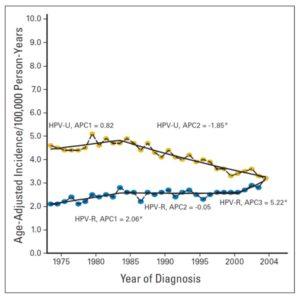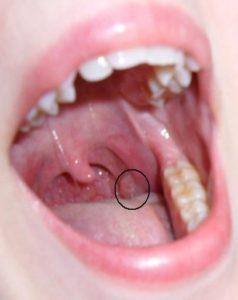The Role of HPF on Cancer Types Around the Head & Neck Areas
Cancer cells made from squamous cells, that develop around the head and neck areas, develop in the mouth due to nose-mouth resultants, mouth-throat resultant, while it might also develop in the throat and the area below the throat. It accounts for about 3% to 4% of all cancer types. It is also the 6th most common cancer type. In addition to consumption of tobacco and alcohol products as one of the leading risk factors, a scientist named Syrjanen has made a breakthrough in 1983, when he found the correlation between this type of cancer and the HPV-linked protein consumption.
Frequency of HPV on Cancer Types Around the Head & Neck Areas
During biopsies, it has been found that between 23% to 35% of all squamous cancer cells which form around the mouth and throat area, contain HPV. The frequency of HPV in mouth-throat cancers is between 45%-89%. HPVs which are detected are mostly type 16 (68-87). Other HPV types detected are; 18, 31, 33, 35, 45, 51, 52, 56, 58, 59 and 68. The epidemiology of these cancer types have shown changes in the last 40 years. The reduction of the tobacco consumption in the Western World, have caused the rise of HPV related cancer types around the head and neck areas with squamous cells. Especially the HPV related mouth cancers are rising around 0.8% annually. HPV related mouth cancers are mostly seen in people between the ages of 40 and 60. It is estimated that, by 2030 the number of mouth and throat cancers will be triple compared to cervical cancer, according to a research carried out in the USA.
HPV related oropharyngeal cancers (mouth-throat) have surpassed the mouth-throat cancers related to the consumption of tobacco and alcohol products in the USA by 2004. The graphic below shows the results of an epidemiologic research.  HPV relation between the mouth & throat cancers are demonstrated with the blue dots that gradually rise from below. The yellow dots represent the oropharyngeal cancer types that develop due to tobacco and alcohol consumption. HPV related mouth-throat cancers are seen mostly on people that are 3 to 5 years younger than the average and men that are positive on type 16. Men are more prone to this type of cancer compared to women.
HPV relation between the mouth & throat cancers are demonstrated with the blue dots that gradually rise from below. The yellow dots represent the oropharyngeal cancer types that develop due to tobacco and alcohol consumption. HPV related mouth-throat cancers are seen mostly on people that are 3 to 5 years younger than the average and men that are positive on type 16. Men are more prone to this type of cancer compared to women.
 Risk Factors
Risk Factors
The risk of having a HPV related squamous cell cancer around the head and neck area rises, as the number of sexual partners with whom the person had vaginal, oral and oral-anal sex increases. This situation has a direct relation with the permanence of oral HPF infections. In today’s world, the age at which the first sexual encounter is experienced is dropping, as the number of sexual partners and the frequency of giving oral sex by both men and women increases. A research conducted in France between 1970 and 2006 have found that the frequency of women giving oral sex have increased from 51% to 91%, while the frequency of men has risen from 55% to 94%. The research demonstrates the increase in HPV related cancers.
In 2010, The International Head and Neck Cancer Epidemiology Consortium have demonstrated the direct correlation between oral sex and mouth-throat cancer HPV relation with the work they have carried out. It has been shown that having 6 or more sexual partners during our lives or having 4 or more sexual partners to whom people have given oral sex to, increased the risk of having oropharyngeal cancer. Having more than 4 sexual partners and giving oral sex at a young age for men, also increased the chance of having tonsil cancer, according to the same consortium.
I can hear you ask; ‘Is there no good news?’ 😊 The good news is, HPV related oropharyngeal cancer types are relatively more benign. On the other hand, just like with cervical cancer for women; the reason for not developing oropharyngeal cancer for men who have oral sex and have Type 16, is still being investigated.
Oral HPV Infection
Research show that, around 10% of men have HPV in their mouth, while for women this number is 3.6%.
There are also studies, which point to the correlation between the increasing number of sexual partners and the increase of oral HPV infections.
There is no indication that point to a relation between kissing from the mouth with the increase of HPV infections.
Studies have also shown that, people who consume tobacco have higher rates of oral HPV infections.
HPV is seen 3 times more frequently on people with cancer related lesions in their mouth area.
Early Diagnosis and What to Do For Protection?
There is no conclusive information on this issue. Well known otolaryngologists in Turkey suggest frequent examinations every 6 months or 1-year period. Additionally, hygiene around the mouth area is important for avoidance. You should especially pay attention to your dental health (which I cannot due to a lack of time). So how can we protect ourselves? The unrealistic advice is; do not have sex 😊. Avoiding oral sex might be a good suggestion. But it’s not a realistic one in today’s world. Another suggestion is to have a secondary protection, meaning a 4-way HPV vaccination. Despite an article published by Cancer magazine in 2016 stating that the vaccination might be effective at preventing oropharyngeal cancer, it might take a long time to gather clear information in order to make a conclusion. This is because it is hard to detect pre-cancerogenic lesions in the mouth, just like in cervix. It is also not easy to diagnose these types of lesions. But the best suggestion with the information gathered, is that vaccination might be helpful in prevention.
Prognosis-Course of Illness
HPV related squamous cell cancers on head and neck areas are detected in more advanced stages, compared to other cancer types. Also the cells in these cancer types have more malign properties.
But HPV related squamous cell cancers respond better to treatment compared to others. The survival rate in the first 3 years of patients with HPV(+) related squamous cell cancers is around 82%, while patients with HPV(-) this rate falls to 57%.
The recurrence rates for HPV(+) related squamous cancer types is higher compared to HPV(-). This is great news. When the starting point is smoking cigarettes and the type is HPV related oropharyngeal cancer, the problem is felt on a larger scale.
The factors that determine the course of the illness on throat and mouth cancers are; HPV situation, smoking situation of the patient and the lymph node involvement.
HPV with Head and Neck Cancers Excluding Mouth and Throat
These tumors are due to nose-mouth resultants, throat, under the throat area and sinuses. These tumors have been studied regarding their relation with HPV(+). High HPV levels have been found to cause these tumors. But the scientific information, on which the course and treatment of these tumors to be determined, is not enough for now.
SOURCES
- https://www.researchgate.net/profile/Shanthi_Marur/publication/44581570_HPV-associated_head_and_neck_cancer_a_virus-related_cancer_epidemic/links/0912f511a58a2a64e6000000.pdf
Chaturvedi AK1, Engels EA, Anderson WF, Gillison ML. Incidence trends for human papillomavirus-related and –unrelated oral squamous cell carcinomas in the United States. J Clin Oncol. 2008 Feb 1;26(4):612-619.
Heck JE, Berthiller J, Vaccarella S, et al. Sexual behaviours and the risk of head and neck cancers: a pooled analysis in the International Head and Neck Cancer Epidemiology (INHANCE) consortium. Int J Epidemiol 2010;39:166–181.
14 Kasım 2013 tarihinde Prof. Dr. Süleyman Engin Akhan tarafından yayınlanmış ve 13 Nisan 2018 tarihinde de son güncelleme yapılmıştır.

